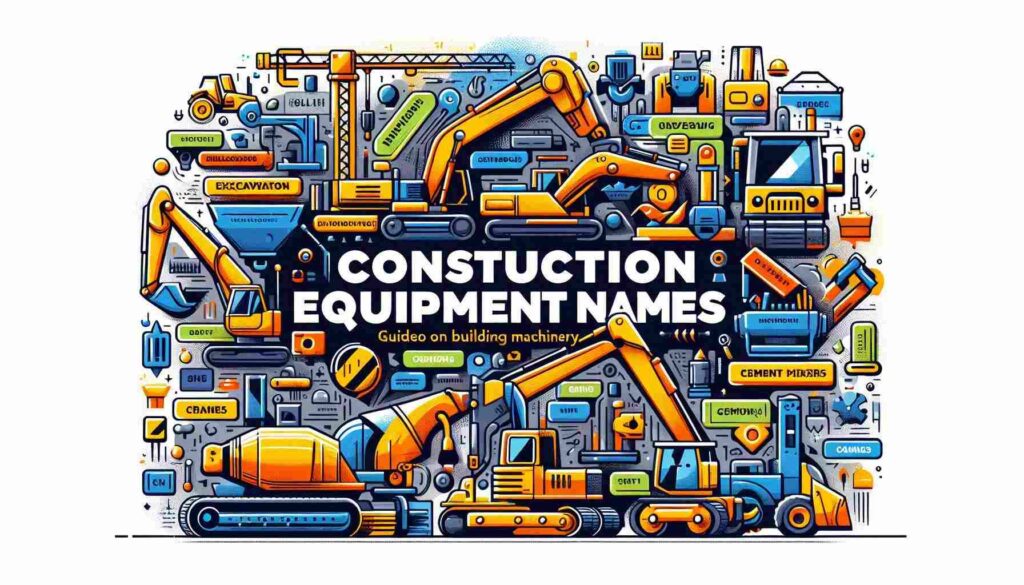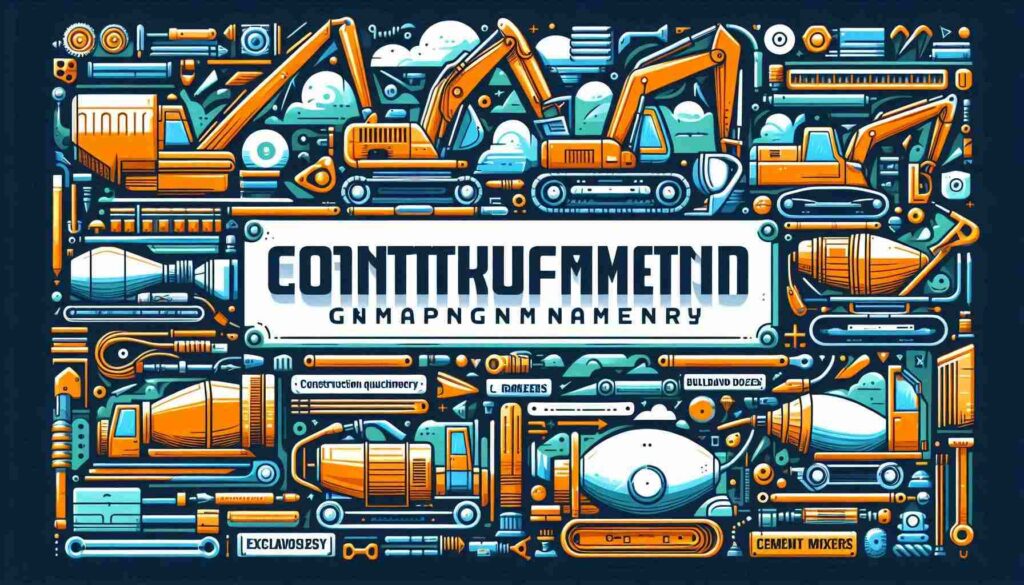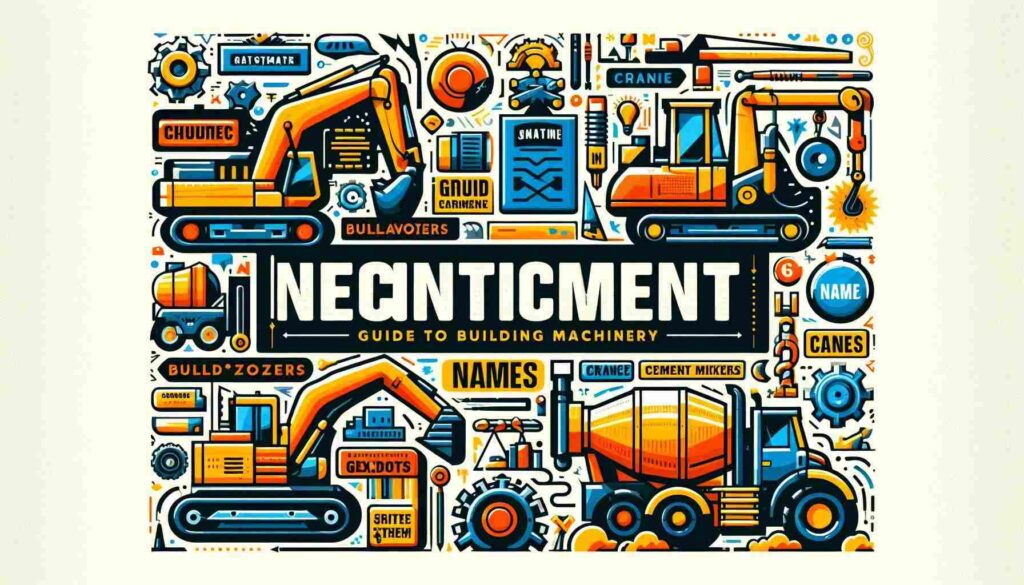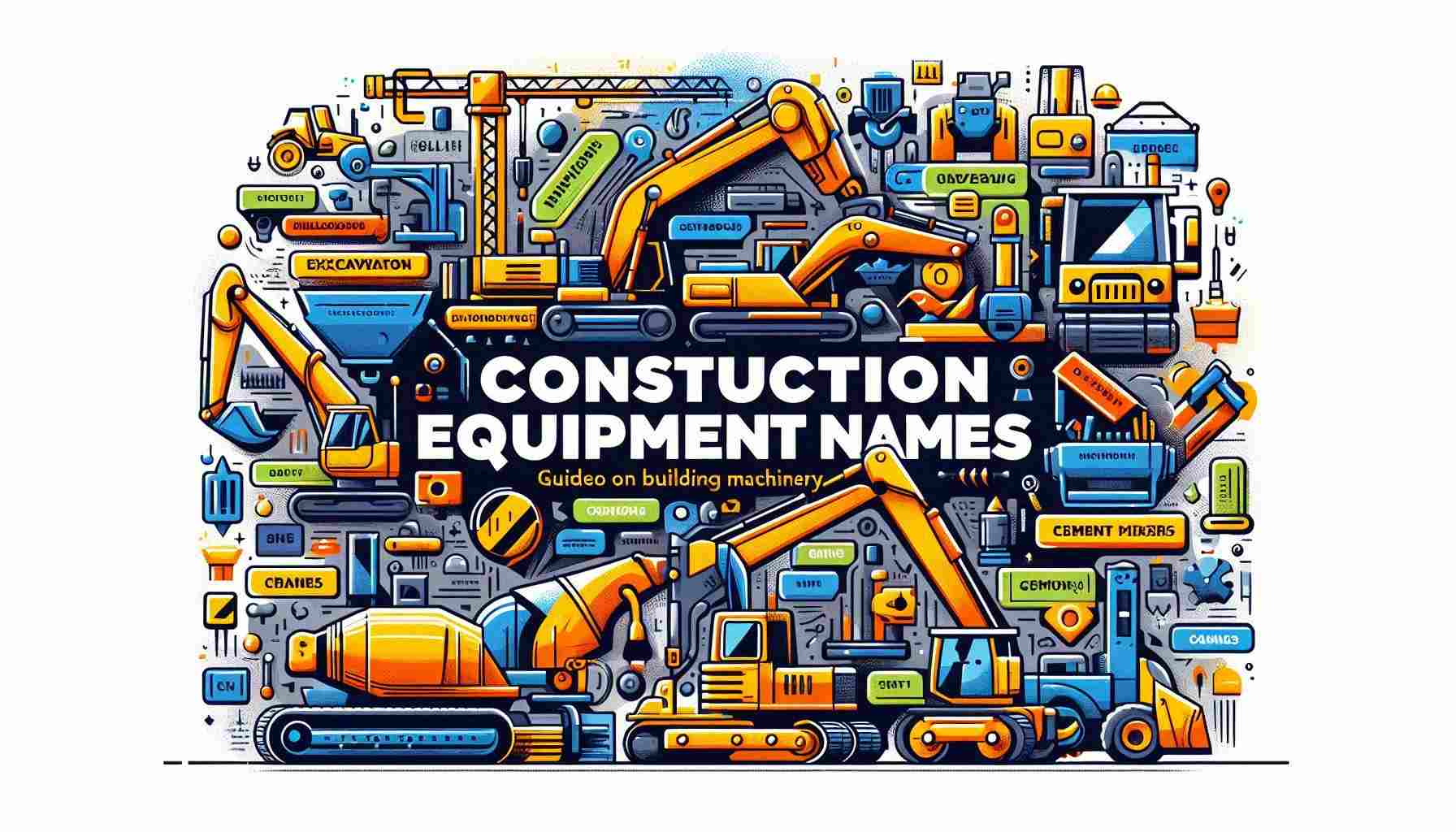Ever walked onto a construction site and felt overwhelmed by the sheer variety of machinery around you? You’re not alone! Construction equipment comes in all shapes and sizes, each with its own unique purpose. From towering cranes to nimble excavators, these mechanical marvels are the unsung heroes of the building world. They’re the muscle behind our skyscrapers, bridges, and homes, turning architectural dreams into concrete reality.
Understanding Construction Equipment Names isn’t just for the hard-hat crowd. Whether you’re a DIY enthusiast, a curious onlooker, or someone considering a career in construction, knowing your way around these steel giants can be incredibly useful. Plus, let’s face it, there’s something undeniably cool about massive machines that can move mountains (almost literally)!
Key Takeaways
- Construction equipment refers to heavy-duty vehicles and machinery used in building projects
- Different types of equipment serve various purposes, from earthmoving to material handling
- Knowing equipment names and functions is crucial for safety and efficiency on construction sites
- Proper operation and maintenance of construction machinery require specialized training
- Technological advancements are continually improving the capabilities and efficiency of construction equipment

The ABCs of Construction Equipment
Let’s start with the basics. Construction equipment, also known as heavy equipment or earthmoving equipment, includes a wide range of machinery designed for construction tasks. These mechanical behemoths are built to perform tasks that would be impossible or incredibly time-consuming for humans to do manually.
From digging foundations to lifting heavy materials, each piece of equipment has a specific role to play in the construction process. Some common categories include:
- Earthmoving equipment
- Material handling equipment
- Construction vehicles
- Road construction equipment
Now, let’s dive into some of the most common types of construction equipment you’re likely to encounter on a job site.
Earthmoving Marvels: Excavators and Bulldozers
When it comes to moving earth, two machines reign supreme: excavators and bulldozers. These powerhouses are often the first on the scene, preparing the ground for the construction to come.
Excavators
Excavators are like the Swiss Army knives of construction equipment. With their long arm (boom) and bucket, they can dig trenches, holes, and foundations with impressive precision. But that’s not all! They can also be used for:
- Lifting heavy objects
- Dredging rivers
- Demolition work
- Forestry work
There’s something almost graceful about watching a skilled operator maneuver an excavator. It’s like a mechanical ballet, with the machine pivoting on its tracks and the arm swinging smoothly through the air.
Bulldozers
If excavators are the precision instruments of earthmoving, bulldozers are the brute force. These tracked vehicles with a wide, flat blade at the front are designed to push large quantities of soil, rubble, or other materials.
Bulldozers are invaluable for:
- Clearing land
- Spreading soil
- Rough grading
- Removing debris
The raw power of a bulldozer is something to behold. I remember watching one clear a field for a new housing development – it was like watching the landscape transform before my eyes!
Reaching for the Sky: Cranes and Lifts
Once the ground is prepared, it’s time to start building upwards. That’s where cranes and lifts come into play.
Tower Cranes
Tower cranes are the gentle giants of the construction world. These tall, stationary cranes are a common sight on large construction projects, especially in urban areas. They’re used to lift and move heavy materials like steel beams, large tools, and even other pieces of equipment.
The operator sits in a cab at the top of the crane, often hundreds of feet in the air. It takes nerves of steel and incredible skill to operate these machines safely. I once had the chance to climb a tower crane (with proper safety gear, of course), and the view from up there was both terrifying and exhilarating!
Mobile Cranes
For projects that require more flexibility, mobile cranes are the go-to choice. These cranes are mounted on wheels or tracks, allowing them to move around the construction site as needed. They come in various sizes, from small truck-mounted cranes to massive all-terrain cranes capable of lifting hundreds of tons.
Aerial Work Platforms
Also known as cherry pickers or boom lifts, these machines are designed to lift workers to heights that would be unsafe or impractical to reach with ladders. They’re commonly used for:
- Painting
- Maintenance work
- Window installation
- Tree trimming
I once used a small scissor lift for a home renovation project, and it made reaching the high ceilings a breeze. It’s amazing how much easier and safer these machines make certain tasks!

The Workhorses: Loaders and Trucks
While the big machines get a lot of attention, it’s often the more modest equipment that keeps a construction site running smoothly.
Wheel Loaders
Wheel loaders, also known as front-end loaders, are versatile machines used for loading materials into trucks, moving dirt, and even some light excavation work. With their large bucket at the front and four-wheel drive, they can handle a variety of terrains and materials.
I’ve always been impressed by how quickly a skilled wheel loader operator can fill a dump truck. It’s like watching a well-choreographed dance between the two machines.
Dump Trucks
Speaking of dump trucks, these hauling heroes are essential for moving large quantities of materials around and off the construction site. From standard dump trucks to massive off-highway trucks used in mining operations, these vehicles come in a range of sizes to suit different projects.
The satisfying ‘thump’ of a dump truck bed dropping its load is one of the iconic sounds of a construction site. It’s a sound that means progress is being made!
Skid Steer Loaders
For tighter spaces and more delicate work, skid steer loaders are the go-to choice. These compact, highly maneuverable machines can be fitted with a variety of attachments, making them incredibly versatile. They can be used for:
- Digging
- Grading
- Lifting materials
- Snow removal
- Landscaping
I once rented a skid steer loader for a backyard landscaping project, and I was amazed at how much work such a small machine could do. It made what would have been weeks of backbreaking labor into a weekend project!
As we’ve seen, the world of construction equipment is vast and varied. Each machine plays a crucial role in bringing our built environment to life. But we’ve only scratched the surface! In the next section, we’ll explore more specialized equipment and delve into the latest technological advancements that are shaping the future of construction machinery.
Here’s the continuation of the blog post in HTML format, following your guidelines:

Paving the Way: Road Construction Equipment
Road construction is a whole different ballgame, with its own set of specialized equipment. These machines are designed to create smooth, durable surfaces that can withstand years of heavy traffic.
Asphalt Pavers
Asphalt pavers are the unsung heroes of our smooth highways. These machines lay down a uniform layer of asphalt, creating that satisfying black ribbon of road. I once watched a paving crew resurface a local street, and it was mesmerizing how quickly they transformed the pothole-ridden mess into a pristine surface.
Compactors and Rollers
After the asphalt is laid, it needs to be compacted to ensure durability. That’s where compactors and rollers come in. These machines come in various sizes and types, including:
- Smooth drum rollers
- Pneumatic tire rollers
- Vibratory plate compactors
The sight of a massive roller smoothing out fresh asphalt is oddly satisfying. It’s like watching a giant steam iron pressing out wrinkles in the road!
Concrete Jungle: Specialized Concrete Equipment
Concrete is the backbone of modern construction, and there’s a whole range of equipment dedicated to working with this versatile material.
Concrete Mixers
We’ve all seen those iconic rotating drum trucks on the road. These mobile concrete mixers, also known as transit mixers, keep concrete in a liquid state while transporting it to the construction site. It’s amazing how something as simple as a rotating drum can keep tons of concrete from setting prematurely.
Concrete Pumps
For high-rise buildings or hard-to-reach areas, concrete pumps are a game-changer. These machines can pump liquid concrete through pipes, allowing it to be placed precisely where it’s needed. I once saw a pump in action on a bridge construction project, shooting concrete over 100 feet in the air. It was like watching a massive water cannon, but with concrete!
Power Trowels
After concrete is poured, power trowels are used to create a smooth, flat surface. These machines look a bit like a giant fan blade spinning on the concrete. Watching a skilled operator “ride” a power trowel is quite a sight – it’s like they’re surfing on concrete!
The Future of Construction Equipment: Technology and Innovation
The construction industry is embracing technology in a big way, and it’s changing the face of construction equipment.
GPS and Machine Control Systems
Many pieces of modern construction equipment are now equipped with GPS and machine control systems. These technologies allow for incredibly precise grading and excavation, reducing waste and improving efficiency. It’s amazing to think that the same technology that helps us navigate to the grocery store is now shaping our landscapes!
Remote-Controlled and Autonomous Equipment
Remote-controlled and even fully autonomous construction equipment is becoming a reality. This technology allows operators to control machines from a safe distance, which is particularly useful in hazardous environments. I recently saw a demonstration of a remote-controlled excavator, and it felt like watching a giant video game come to life!
Electric and Hybrid Equipment
As the world moves towards more sustainable practices, construction equipment is following suit. Electric and hybrid machines are becoming more common, offering reduced emissions and quieter operation. It’s exciting to think that the construction sites of the future might be cleaner and quieter than ever before.
The world of construction equipment is vast and constantly evolving. From the massive earthmovers that shape our landscapes to the precise instruments that put the finishing touches on our buildings, each piece of equipment plays a crucial role in creating the world around us. As technology continues to advance, who knows what amazing machines we’ll see on construction sites in the future? One thing’s for sure – the construction industry will always need skilled operators who can work in harmony with these mechanical marvels. So the next time you pass a construction site, take a moment to appreciate the incredible machines and the skilled professionals who operate them. They’re not just building structures; they’re shaping our world, one scoop, lift, and pour at a time.
Frequently Asked Questions
1. What’s the biggest piece of construction equipment?
The title of “biggest” can vary depending on how you measure it, but one of the largest is the Bagger 293 excavator. It’s about 315 feet tall, 738 feet long, and weighs 14,200 tons! It’s so massive that it’s only used in very large mining operations. For comparison, it’s about as tall as a 30-story building!
2. How much does a typical excavator cost?
The cost of an excavator can vary widely based on size and capabilities. A small, 1-2 ton mini excavator might cost around $20,000-$50,000, while a standard 20-ton excavator could run anywhere from $100,000 to $500,000. Large excavators used in mining can cost millions! Remember, many construction companies rent equipment rather than buying it outright.
3. What’s the difference between a backhoe and an excavator?
While they might look similar at first glance, backhoes and excavators have some key differences. A backhoe is a tractor-like vehicle with a loader bucket on the front and a digging arm (the “backhoe”) on the back. An excavator, on the other hand, has a boom and digging bucket mounted on a rotating platform. Excavators are generally larger and more powerful, while backhoes are more versatile for smaller jobs.
4. How long does it take to learn to operate construction equipment?
The learning curve varies depending on the equipment and the individual, but it generally takes several weeks to several months to become proficient with a piece of heavy equipment. Many operators start with smaller machines and work their way up. Full mastery can take years of experience. Most operators undergo formal training and certification programs to ensure safe operation.
5. What’s the most versatile piece of construction equipment?
Many would argue that the skid steer loader is one of the most versatile pieces of equipment. With its compact size and ability to use a wide variety of attachments, it can perform tasks ranging from digging and grading to lifting and demolition. Backhoes are also highly versatile, combining the functions of a loader and an excavator in one machine.
6. How do construction crews decide what equipment to use for a project?
Choosing the right equipment involves considering several factors:
- The nature and scale of the project
- The type of terrain and soil conditions
- The available space on the job site
- Budget constraints
- Timeline requirements
Project managers and engineers typically work together to determine the most efficient and cost-effective equipment mix for each specific project.
7. Are there any women operating heavy construction equipment?
Absolutely! While construction has traditionally been a male-dominated field, more and more women are entering the industry, including as heavy equipment operators. Organizations like the National Association of Women in Construction (NAWIC) are working to increase opportunities and support for women in all aspects of construction. Many women find operating heavy equipment to be a rewarding and well-paying career.
8. How has technology changed construction equipment in recent years?
Technology has had a massive impact on construction equipment. Some key advancements include:
- GPS and machine control systems for precise grading
- Telematics for remote monitoring and maintenance
- Hybrid and electric powertrains for reduced emissions
- Advanced safety features like 360-degree cameras
- Autonomous and semi-autonomous operation capabilities
These technologies have made equipment more efficient, safer, and easier to operate.
9. What’s the most dangerous piece of construction equipment?
All construction equipment can be dangerous if not operated properly, but some machines require extra caution. Cranes, for instance, can be particularly hazardous due to the risk of tipping or dropping heavy loads. Excavators and bulldozers also pose significant risks due to their size and power. That’s why proper training, safety protocols, and constant vigilance are crucial on any construction site.
10. How do construction companies maintain their equipment?
Maintaining construction equipment is crucial for safety, efficiency, and longevity. Most companies follow a comprehensive maintenance program that includes:
- Regular inspections and preventative maintenance
- Scheduled oil changes and lubrication
- Prompt repair of any identified issues
- Thorough cleaning to prevent buildup of dirt and debris
- Proper storage when not in use
Many modern machines also have onboard computers that can alert operators to potential issues before they become serious problems. Proper maintenance not only keeps equipment running smoothly but also significantly extends its lifespan.






